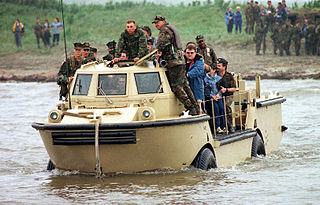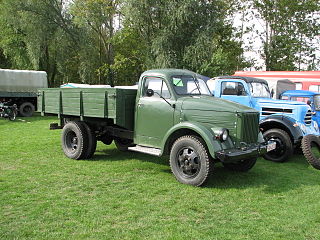
An amphibious vehicle, is a vehicle that is a means of transport viable on land as well as on or under water. Amphibious vehicles include amphibious bicycles, ATVs, cars, buses, trucks, railway vehicles, combat vehicles and hovercraft.

The GAZ-51 was a Soviet truck manufactured by GAZ. Its first prototypes were produced before the end of World War II and has been influenced by Studebaker US6. The mass production started in 1946.

A half-track is a civilian or military vehicle with regular wheels at the front for steering and continuous tracks at the back to propel the vehicle and carry most of the load. The purpose of this combination is to produce a vehicle with the cross-country capabilities of a tank and the handling of a wheeled vehicle.

The GAZelle is a series of light commercial vehicles: pickup trucks, vans and minibuses made by Russian car manufacturer GAZ. At the time of the dissolution of the Soviet Union and transition to a market economy, the Russian automobile industry had not produced a much-demanded LCV similar to the Ford Transit or VW T4 class. The GAZelle shares many parts with the company's passenger cars, in fact, models produced until 1998 had the same grille. Riga Autobus Factory, which formerly manufactured minibuses for the whole USSR, remained in Latvia, now required its vehicles be sold to the now-foreign Russian market for hard currency. Responding to this market opportunity, GAZ swiftly developed its own LCV called GAZelle, that taken together with its lighter version Sobol now account for the majority of the Russian van and light truck market and has strong positions in the markets of other CIS countries, ranking as GAZ's most popular and successful products.

The ZIM-12 was a Soviet full-size luxury car produced by the Gorky Automotive Plant (GAZ) from 1950 until 1960. It was the first executive car produced by GAZ and the first one to have the famous leaping gazelle hood ornament. The car was built to serve high and medium rank Soviet nomenklatura, but was also readily available as a taxi and ambulance. Unlike its successors, ZIM was the only Soviet executive class full-size car that was actually made available for private ownership. A total of 21,527 examples were built.

The BTR-80 is an 8×8 wheeled amphibious armoured personnel carrier (APC) designed in the Soviet Union. It was adopted in 1985 and replaced the previous vehicles, the BTR-60 and BTR-70, in the Soviet Army. It was first deployed during the Soviet–Afghan War.

The BTR-40 is a Soviet non-amphibious, wheeled armoured personnel carrier and reconnaissance vehicle. It is often referred to as the Sorokovka in Soviet service. It is also the first mass-produced Soviet APC. It was eventually replaced in the APC role by the BTR-152 and in the scout car role by the BRDM-1.

A Kégresse track is a kind of rubber or canvas continuous track which uses a flexible belt rather than interlocking metal segments. It can be fitted to a conventional car or truck to turn it into a half-track, suitable for use over rough or soft ground. Conventional front wheels and steering are used, although skis may also be fitted. A snowmobile is a smaller ski-only type.

BTR (БТР), from Bronetransportyor/Bronetransporter, is any of a series of Soviet or post-Soviet military armoured personnel carriers.

The BA-64 was a Soviet four-wheeled armoured scout car. Built on the chassis of a GAZ-64 or GAZ-67 jeep, it incorporated a hull loosely modeled after that of the Sd.Kfz. 221. The BA-64 was developed between July and November 1941 to replace the BA-20 then in service with armoured car units of the Red Army. Cheap and exceptionally reliable, it would later become the most common Soviet wheeled armoured fighting vehicle to enter service during World War II, with over 9,000 being manufactured before production ended.

BTR-90 (GAZ-5923) is an 8×8 wheeled armored personnel carrier developed in Russia, designed in 1993 and first shown publicly in 1994. It is a larger version of the BTR-80 vehicle, fitted with a BMP-2 turret. Armour protection is improved compared with the BTR-80, giving protection from 14.5 mm projectiles over the frontal arc.

The Type 96 Wheeled Armored Personnel Carrier is an armoured vehicle that entered service with Japan in 1996. This vehicle complements the existing fleet of tracked Type 73 Armored Personnel Carriers already in service.

The GAZ M1 (“Эмка“/”Emka”) was a passenger car produced by the Soviet automaker GAZ between 1936 and 1943, at their plant in Gorky.

The VPK-7829 Bumerang is a modular amphibious wheeled infantry fighting vehicle and armored personnel carrier being developed by Russian Military Industrial Company (MIC) for the Russian army.
This page is based on this
Wikipedia article Text is available under the
CC BY-SA 4.0 license; additional terms may apply.
Images, videos and audio are available under their respective licenses.


















